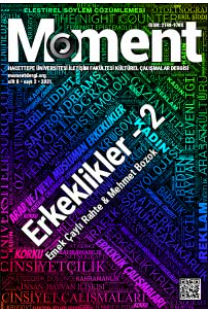Seslerin Çarpışması: Iris Murdoch'ın Rahibeler ve Askerler Romanında Kadınların Sesleri
Seslerin/benlerin yaratılmasının önemini derinden anlayan bir yazar olan Iris Murdoch, çoğunlukla romanlarında zamansız bir insan gerçeğini keşfeder. Bakhtin, “diyalojik” ya da “karnavalesk” olarak tanımladığı demokratik bir dili anlatmaya yönelik bir çerçeve geliştirmiştir ve içinde birçok sesi barındıran bir diyaloğun yer aldığı bir dünya umudunu taşımıştır. Bakhtin’in en önemli katkılarından biri “polifoni”, “çokseslilik” kavramıdır. Bakhtin polifonik romanın “tamamıyla diyalojik olduğunu” ileri sürmektedir. (Bakhtin, 1973, p. 40). Bakhtin’e göre kültür dili, kesişen dillerin - sınıf, meslek, aktivite, nesil, cinsiyet, bölge - kullanımı ve çok çeşitli etkileşim anlamları ile doludur. Iris Murdoch’ın Nuns and Soldiers (Rahibeler ve Askerler) romanı etik, ahlaki ve felsefi konularla ilgili olarak sıklıkla incelenmiştir. Bununla birlikte, bu konuların kadın karakterler için nasıl ses bulduğunu keşfetmek de önemlidir. Bu sebeple, bu makalenin amacı Iris Murdoch’ın Nuns and Soldiers adlı romanında yer alan kadın karakterlerin seslerini Mikhail Bakhtin’in roman kuramı ışığında incelemektir.
Anahtar Kelimeler:
diyalojizm, polifoni (çokseslilik), karnavalesk, monoloji (tek seslilik), kadın sesi, Iris Murdoch
Combat of Voices: Female Voices in Iris Murdoch’s Nuns and Soldiers
Iris Murdoch, a writer with a profound understanding of the importance of creating voices/selves, often explored human truths that are timeless in her novels. Bakhtin developed a frame of work in which he mainly aimed at describing a democratic language which was “dialogical” or “carnivalesque”. A world of interchange, of a dialogue between many voices is what Bakhtin hoped for. One of the great contributions of Bakhtin is the concept of polyphony (multivocality or multi-voicedness). He suggests that “the polyphonic novel as a whole is thoroughly dialogical” (Bakhtin, 1973, p. 40). To Bakhtin the language of a culture is full of intersecting language uses - those of class, profession, activity, generation, gender, region and a rich variety of interacting significances. Iris Murdoch’s novel Nuns and Soldiers has often been studied in relation to the ethical, moral and philosophical issues; however, it is also significant to explore how these issues are voiced for female characters. Therefore, the aim of this paper is to explore the voices of female characters in Iris Murdoch’s Nuns and Soldiers on the basis of Bakhtinian theory of the novel.
Keywords:
dialogism, polyphonic (multi-voiced), carnivalistic (carnivalesque), monologic (single-voiced), female voice, Iris Murdoch,
___
- Bakhtin, Mikhail. Problems of Dostoevsky's Poetics. (Ardis, 1973).
- Bakhtin, Mikhail. The Dialogic Imagination: Four Essays ed. Michael Holquist, tr. Caryl Emerson and Michael Holquist (Austin: Texas University Press, 1981).
- Bakhtin, Mikhail. Rabelais and His World (Indiana University Press, 1984).
- Bakhtin, Mikhail. Art and Answerability: early philosophical essays (Austin: University of Texas Press,1990).
- Conradi, Peter. Iris Murdoch: The Saint and the Artist (London: Macmillan, 1989).
- Gardiner, Michael. The Dialogics of Critique: M.M.Bakhtin and the theory of ideology (London: Routledge, 1992).
- Heusel, Barbara S. Patterned Aimlessness, Iris Murdoch Novels of the 1970s and 1980s (London: The University of Georgia Press, 1995).
- Hirschkop, Ken. Bakhtin and cultural theory (Manchester: Manchester University Press, 1989).
- Lodge, David. After Bakhtin: essays on fiction and criticism (London: Routledge, 1990).
- Kristeva,Julia, Desire in language: a semiotic approach to literature and art (Oxford B.Blackwell , 1982).
- Morris, Pam ed. The Bakhtin Reader: Selected Writings of Bakhtin, Medvedev and Volosinov. (London: Edward Arnold, 1994).
- Morson, S. Gary and Caryl Emerson. Rethinking Bakhtin, Extensions and Challenges (Evanston, Illinois: North Western UP, 1989).
- Murdoch, Iris. Nuns and Soldiers (Middlesex: Penguin, 1980).
- Nicol, Bran. Iris Murdoch The Retrospective Fiction (London: Macmillan, 1999).
- Vice, Sue, Introducing Bakhtin (Manchester: Manchester University Press, 1997).
- Voloshinov, V.N. Marxism and the Philosophy of Language (1929) tr. David Shepherd (New York and London: Seminar Press, 1973)
- ISSN: 2148-970X
- Yayın Aralığı: Yılda 2 Sayı
- Başlangıç: 2014
- Yayıncı: Hacettepe Üniversitesi İletişim Fakültesi
Sayıdaki Diğer Makaleler
Vizesiz Hikâyeler: Fas'tan ve Türkiye'den Umuda Dijital Hikâyeler
ANLATIYLA KURULANLAR, KIRILANLAR, BULUŞANLAR...
Yollar, İkilemler ve Düşler: Mülteci Kadınlardan Dijital Hikâyeler
Gidenler, Kalanlar, Yoldakiler, Bağlantılar: Medya ve Hareketliliğin Antropolojisi
John Hartley ile Söyleşi: İnsanlar, Kurmaca ve Kültürel Bilim Üzerine
Sosyal Bilimler Alanındaki Akademisyenlerin Bilgi ve İletişim Teknolojileri Anlatıları
Çağımızın Hikâye Anlatıcılığı Olarak Halkla İlişkiler: Vehbi Koç Biyografileri Üzerine Bir İnceleme
